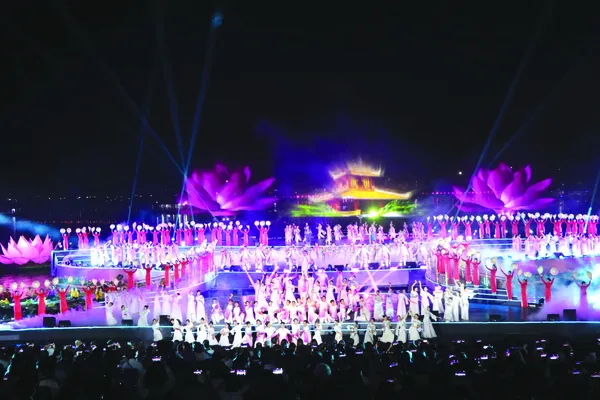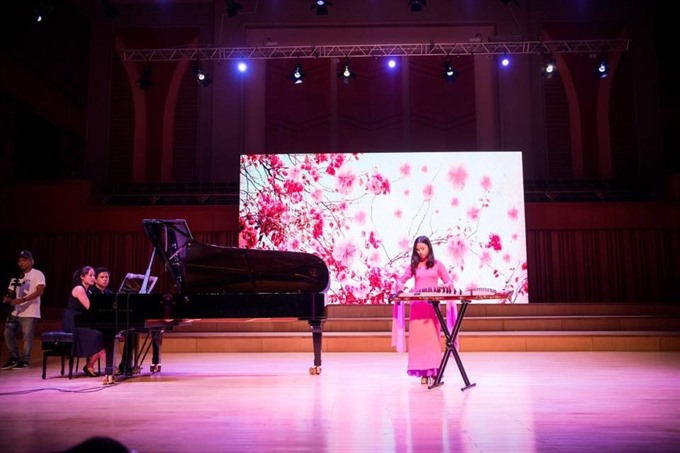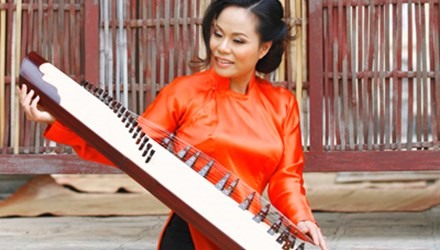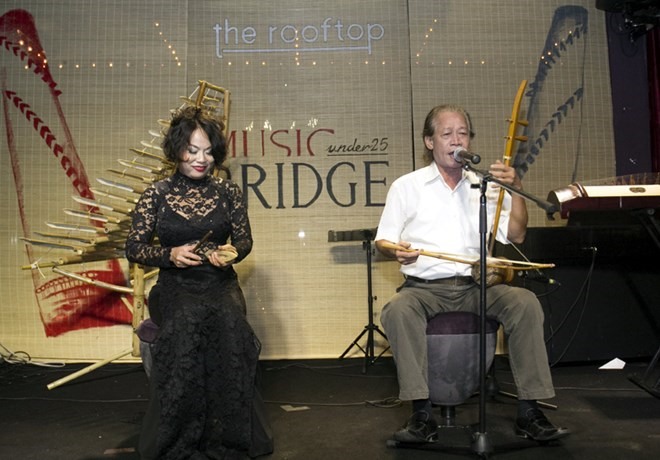 Features
Features

Zitherist Vân Ánh’s international collaborations have put Vietnamese traditional music on the world map. Now, she is working to preserve and further popularise this art form. Hà Nguyễn reports
 |
| Cultural legacy: Đỗ Minh Phương, one of Ánh’s talented students plays đàn tranh at the Việt Nam National Academy of Music in Hà Nội. |
by Hà Nguyễn
World renowned traditional musician and composer Võ Vân Ánh is returning to Việt Nam, her homeland, to continue implementing her Master-Apprentice programme.
The programme involves having famous musicians teach Vietnamese folk music to students from the country and abroad.
This year, it aims to help young music learners who love Vietnamese traditional music and instruments like the đàn tranh (16-chord zither), đàn bầu (monochord) and several others to connect with eminent people like artists Xuân Hoạch and Trọng Thủy.
After one year, participants will perform before community as part of efforts to preserve and develop the arts, Ánh said.
One of the ideas she is pursuing is to have the students play once a week at Quán Ăn Ngon chain of restaurants, a culinary and tourism hub in Hà Nội or at the ancient Văn Miếu (Temple of Literature).
“Many of my students from the US and other countries such as Spain and Portugal who are accompanying me on this trip will join the programme,” Ánh said.
She set up a fund called Music Bridge in 2013 to encourage young musicians to compose, perform and teach traditional music and instruments. Their works would be an outlet for them to express their sentiments.
“By doing so, we can develop and preserve our culture. Two workshops have been held in HCM City since the fund was set up,” Ánh told Việt Nam News.
Ánh said movie producers (in the US and other countries) who wanted to use her music for their films have donated to the fund. For example, a producer will not have to pay royalties for her music but donate money to the Music Bridge fund.
Ánh said she was particularly grateful to Phạm Thị Bích Hạnh, the owner and founder of Quán Ăn Ngon restaurant chain in Hà Nội for her tireless contributions to the fund, organising concerts for her and artists and auctioning many items including her đàn tranh.
Hạnh said her aim in setting up the Quán Ăn Ngon restaurants was not only to introduce and develop traditional Vietnamese cuisine but also to preserve it for future generations. Ánh has a similar purpose, so “our thoughts meet, and I try to help".
“She not only has a great passion for traditional music but also knows how to inspire young people to get involved and love the art,” Hạnh said.
Hạnh’s daughters Đỗ Minh Phương, 15, and Đỗ Hà Phương Anh, 11, have been learning to play the piano, but they are also keen on the đàn tranh.
“We like the way teacher Ánh performs the đàn tranh and the way she teaches us,” said Phương.
For example, when playing the folk song Kéo Lưới (Drawing Fishing Net), Ánh performs with the action of a real fisherman casting and drawing the net.
“I understand the hard work a fisherman has to do to earn a living. Thanks to her, my performance improves every day,” said Phương. She said she loved the đàn tranh because it helps her understand her country’s cultural past.
“She teaches us how to express our feeling and sentiments through breathing and moving while performing,” said Phương, who played the zither with a group of foreign students at the Kennedy Center in June 2015.
 |
| Instrumental: Võ Vân Ánh plays đàn tranh at a traditional music club in Hà Nội. Photos by Hà Nguyễn |
Ánh tries to compose music that the youth can play on traditional instruments so that the music can give voice to the new generation and express their feeling.
She recalled: “Once I had to make up a special version to teach my Japanese student. One day, I told her to play a Vietnamese folk song in which she had to mimic the sound of rain in Việt Nam. She played again and again but I couldn’t hear the sound I expected. I told her that the raining sound in the country is often heavy, causing leaves to fall and tree branches to break.
“The Japanese student understood. She said the sound of rain in her country is not as heavy as ours. So after hearing my explanation and watching my performance, she can play the Vietnamese folk song well,” said Ánh.
Ánh recalled the oldest student she’d ever had, an American woman named Laura Lopez, 84, who teaches piano to her two daughters at her home. Once, Laura had a chance to enjoy Ánh’s đàn tranh performance.
Laura said Ánh played the instrument and her Vietnamese folk songs beautifully that it inspired her to learn it. Laura was very happy when Ánh agreed to teach her.
Laura added through it she had come to know Vietnamese culture and could understand the origin of the songs she played. She even joined others to perform the Vietnamese instrument before US audiences.
 |
| Singing folk song: Ánh performs her music at the Rooftop Restaurant &Bar in Hà Nội. |
International co-operation
Ánh’s collaboration with many world famous musicians has expanded her musical repertoire and helped her share Vietnamese music with international audiences.
“When I first resettled in the US, it took a long time to be understood by others, because foreigners only knew Việt Nam through the war, not its culture. So I have tried my utmost to bring our culture to the world through my music composing and teaching.”
Ánh was born in 1975 in Hà Nội. She began learning traditional music at the Hà Nội Conservatory of Music (now the Việt Nam National Academy of Music) since she was six. She graduated from the school in 1992.
Bích Vượng, one of her teachers, said Ánh was always a leading student in the school. She won the first prize at the National Zither Competition and a Best Performance Award in HCM City in 1995.
Since settling in the US in 2001, she has focused on collaborating with musicians across different music genres to create new works, bringing Vietnamese traditional music to a wider audience and preserving her cultural legacy through teaching.
In 2002, she released her first CD, Twelve Months, Four Seasons. Her third CD, Three Mountain Passes, released in 2013, featured her as the guest artist with the Kronos Quartet.
Ánh has also collaborated with Yo-Yo Ma, the Southwest Chamber Music, Eastby Oakland Symphony and other World Music (WM) artists. She has been invited and participated as screening judge in the WM category for the 2015 and 2016 Grammy Awards. She recently became the first Vietnamese artist to perform at at the White House.
Her “Odyssey – from Việt Nam to America” premiered at the Kennedy Center in 2016. This work aimed to highlight the incredible power of the human spirit to survive as embodied by the so-called boat people. It also sought to deliver the message of forgiveness, peace and unity.
Her works have earned high praise from the BBC, the Los Angeles Times and other media outlets. It was chosen among the National Public Radio’s (NPR) 10 Favorite World Music Albums of 2013.
Mark Swed of the Times said: “Võ’s Three Mountain Pass which includes her music and traditional Vietnamese pieces on a number of Vietnamese instruments interestingly begs the question of what is American music, especially since a knockout on the disc is her transcription of French composer Erike Satie’s Gnossienne No 3.”
Molly Sheredan of the New Music Box said: “Indeed, Võ’s energy and enthusiasm for musical creativity seems to transcend any particular instrument and instead feed of a fundamental sonic curiosity as well as a desire to reflect on her culture heritage and share those sounds with new ears.
Heather Morris of the Peninsula Review wrote: “Her appearance was dramatic, in a stunning costume and headdress, her music was riveting, her stage presence theatrical and her contribution to Vietnamese music culture outstanding.”
Despite winning a lot of successes and titles, Ánh still has a wish to return to Việt Nam and bring together traditional music lovers to popularize the art and preserve it.
She wants the State to pay more attention to traditional music artists because they are part of “Việt Nam’s giant library of culture”. VNS




